Harmony Search Optimisation of Dispersed Laminated Composite Plates
Abstract
1. Introduction
2. Methods
The Harmony Search Optimisation Process
3. Results
3.1. CFRP Plates
3.2. Boron/Epoxy Plates
3.3. Fiberglass Plates
4. Discussion
5. Conclusions
Author Contributions
Funding
Conflicts of Interest
References
- Tornabene, F.; Fantuzzi, N.; Bacciocchi, M. Linear Static Behavior of Damaged Laminated Composite Plates and Shells. Materials 2017, 10, 811. [Google Scholar] [CrossRef]
- Zhang, Y.; Yang, Y.; Du, W.; Han, Q. Research on Finite Element Model Modification of Carbon Fiber Reinforced Plastic (CFRP) Laminated Structures Based on Correlation Analysis and an Approximate Model. Materials 2019, 12, 2623. [Google Scholar] [CrossRef] [PubMed]
- Anish; Chaubey, A.; Kumar, A.; Kwiatkowski, B.; Barnat-Hunek, D.; Widomski, M. Bi-Axial Buckling of Laminated Composite Plates Including Cutout and Additional Mass. Materials 2019, 12, 1750. [Google Scholar] [CrossRef] [PubMed]
- Lee, J.-M.; Min, B.-J.; Park, J.-H.; Kim, D.-H.; Jo, H.; Ko, D.-C. Design of Lightweight CFRP Automotive Part as an Alternative for Steel Part by Thickness and Lay-Up Optimization. Materials 2019, 12, 2309. [Google Scholar] [CrossRef]
- Barakat, S.; Abu-Farsakh, G. The use of an energy-based criterion to determine optimum configurations of fibrous composites. Compos. Sci. Technol. 1999, 59, 1891–1899. [Google Scholar] [CrossRef]
- Lin, C.-C.; Yu, A.-J. Optimum weight design of composite laminated plates. Comput. Struct. 1991, 38, 581–587. [Google Scholar] [CrossRef]
- António, C.; Marques, A.T.; Soeiro, A. Optimization of laminated composite structures using a bilevel strategy. Compos. Struct. 1995, 33, 193–200. [Google Scholar] [CrossRef]
- Ghiasi, H.; Pasini, D.; Lessard, L. Optimum stacking sequence design of composite materials Part I: Constant stiffness design. Compos. Struct. 2009, 90, 1–11. [Google Scholar] [CrossRef]
- De Almeida, F.S. Stacking sequence optimization for maximum buckling load of composite plates using harmony search algorithm. Compos. Struct. 2016, 143, 287–299. [Google Scholar] [CrossRef]
- De Almeida, F.S.; Awruch, A. Design optimization of composite laminated structures using genetic algorithms and finite element analysis. Compos. Struct. 2009, 88, 443–454. [Google Scholar] [CrossRef]
- Potgieter, E.; Stander, N. The genetic algorithm applied to stiffness maximization of laminated plates: Review and comparison. Struct. Multidiscip. Optim. 1998, 15, 221–229. [Google Scholar] [CrossRef]
- Ehsani, A.; Rezaeepazhand, J. Stacking sequence optimization of laminated composite grid plates for maximum buckling load using genetic algorithm. Int. J. Mech. Sci. 2016, 119, 97–106. [Google Scholar] [CrossRef]
- Roque, C.; Martins, P. Maximization of fundamental frequency of layered composites using differential evolution optimization. Compos. Struct. 2018, 183, 77–83. [Google Scholar] [CrossRef]
- Lahidjani, M.H.S.; Bargh, H.G. Optimization of laminated composite plates for maximum fundamental frequency using Elitist-Genetic algorithm and finite strip method. J. Glob. Optim. 2011, 54, 707–728. [Google Scholar] [CrossRef]
- Abachizadeh, M.; Shariatpanahi, M.; Yousefi-Koma, A.; Dizaji, A.F. Multi-Objective Optimal Design of Hybrid Laminates Using Continuous Ant Colony Method. In Proceedings of the ASME 2010 10th Biennial Conference on Engineering Systems Design and Analysis, Istanbul, Turkey, 12–14 July 2010; Volume 2, pp. 371–378. [Google Scholar]
- Abachizadeh, M.; Tahani, M. An ant colony optimization approach to multi-objective optimal design of symmetric hybrid laminates for maximum fundamental frequency and minimum cost. Struct. Multidiscip. Optim. 2008, 37, 367–376. [Google Scholar] [CrossRef]
- Wang, W.; Guo, S.; Chang, N. A modified ant colony algorithm for the stacking sequence optimization of a rectangular laminate. Struct. Multidiscip. Optim. 2010, 41, 711–720. [Google Scholar] [CrossRef]
- Aymerich, F.; Serra, M. An ant colony optimization algorithm for stacking sequence design of composite laminates. Comput. Model. Eng. Sci. 2006, 13, 49–66. [Google Scholar]
- Aymerich, F.; Serra, M. Optimization of laminate stacking sequence for maximum buckling load using the ant colony optimization (ACO) metaheuristic. Compos. Part A Appl. Sci. Manuf. 2008, 39, 262–272. [Google Scholar] [CrossRef]
- Sebaey, T.; Lopes, C.; Blanco, N.; Costa, J. Ant Colony Optimization for dispersed laminated composite panels under biaxial loading. Compos. Struct. 2011, 94, 31–36. [Google Scholar] [CrossRef]
- Pai, N.; Kaw, A.; Weng, M. Optimization of laminate stacking sequence for failure load maximization using Tabu search. Compos. Part B Eng. 2003, 34, 405–413. [Google Scholar] [CrossRef]
- Pai, N.; Kaw, A.; Weng, M. The ply stacking optimization for composite laminated structure: Application of tabu search algorithm. Adv. Mater. Res. 2012, 366, 514–517. [Google Scholar]
- Rao, A.R.M.; Arvind, N. A scatter search algorithm for stacking sequence optimisation of laminate composites. Compos. Struct. 2005, 70, 383–402. [Google Scholar] [CrossRef]
- Ho-Huu, V.; Do-Thi, T.; Dang-Trung, H.; Vo-Duy, T.; Nguyen-Thoi, T. Optimization of laminated composite plates for maximizing buckling load using improved differential evolution and smoothed finite element method. Compos. Struct. 2016, 146, 132–147. [Google Scholar] [CrossRef]
- Vosoughi, A.R.; Forkhorji, H.D.; Roohbakhsh, H. Maximum fundamental frequency of thick laminated composite plates by a hybrid optimization method. Compos. Part B Eng. 2016, 86, 254–260. [Google Scholar] [CrossRef]
- Vosoughi, A.R.; Darabi, A.; Forkhorji, H.D. Optimum stacking sequences of thick laminated composite plates for maximizing buckling load using FE-GAs-PSO. Compos. Struct. 2017, 159, 361–367. [Google Scholar] [CrossRef]
- Le-Manh, T.; Lee, J. Stacking sequence optimization for maximum strengths of laminated composite plates using genetic algorithm and isogeometric analysis. Compos. Struct. 2014, 116, 357–363. [Google Scholar] [CrossRef]
- Führer, T. Stiffness degradation of composite skin fields due to strength and buckling onset. Thin Walled Struct. 2017, 119, 522–530. [Google Scholar] [CrossRef]
- Amadio, C.; Fragiacomo, M. Buckling of laminated glass elements in out-of-plane bending. Eng. Struct. 2010, 32, 3780–3788. [Google Scholar] [CrossRef]
- Amadio, C.; Fragiacomo, M. Buckling of Laminated Glass Elements in Compression. J. Struct. Eng. 2011, 137, 803–810. [Google Scholar] [CrossRef]
- Bedon, C.; Amadio, C. Buckling of flat laminated glass panels under in-plane compression or shear. Eng. Struct. 2012, 36, 185–197. [Google Scholar] [CrossRef]
- Smith, M. ABAQUS/Standard User’s Manual, Version 6.9; Dassault Systèmes Simulia Corp: Providence, RI, USA, 2009. [Google Scholar]
- Bekdaş, G.; Nigdeli, S.M.; Yang, X.-S. Sizing optimization of truss structures using flower pollination algorithm. Appl. Soft Comput. 2015, 37, 322–331. [Google Scholar] [CrossRef]
- Cheng, M.Y.; Prayogo, D.; Wu, Y.W.; Lukito, M.M. A Hybrid Harmony Search algorithm for discreet sizing optimization of truss structure. Autom. Constr. 2016, 69, 21–33. [Google Scholar] [CrossRef]
- Degertekin, S.O. Optimum design of steel frames using harmony search algorithm. Struct. Multidiscip. Optim. 2007, 36, 393–401. [Google Scholar] [CrossRef]
- Cakiroglu, C.; Bekdaş, G.; Kim, S.; Geem, Z.W. Optimisation of Shear and Lateral–Torsional Buckling of Steel Plate Girders Using Meta-Heuristic Algorithms. Appl. Sci. 2020, 10, 3639. [Google Scholar] [CrossRef]
- Ulusoy, S.; Kayabekir, A.E.; Bekdaş, G.; Niğdeli, S.M. Metaheuristic Algorithms in Optimum Design of Reinforced Concrete Beam by Investigating Strength of Concrete. Chall. J. Concr. Res. Lett. 2020, 11, 33–37. [Google Scholar] [CrossRef]
- Bekdaş, G. Harmony Search Algorithm Approach for Optimum Design of Post-Tensioned Axially Symmetric Cylindrical Reinforced Concrete Walls. J. Optim. Theory Appl. 2014, 164, 342–358. [Google Scholar] [CrossRef]
- Kayabekir, A.E.; Toklu, Y.C.; Bekdaş, G.; Nigdeli, S.M.; Yucel, M.; Geem, Z.W. A Novel Hybrid Harmony Search Approach for the Analysis of Plane Stress Systems via Total Potential Optimization. Appl. Sci. 2020, 10, 2301. [Google Scholar] [CrossRef]
- Kayabekir, A.E.; Bekdaş, G.; Nigdeli, S.M.; Geem, Z.W. Optimum Design of PID Controlled Active Tuned Mass Damper via Modified Harmony Search. Appl. Sci. 2020, 10, 2976. [Google Scholar] [CrossRef]
- Bekdaş, G.; Arama, Z.A.; Kayabekir, A.E.; Geem, Z.W. Optimal Design of Cantilever Soldier Pile Retaining Walls Embedded in Frictional Soils with Harmony Search Algorithm. Appl. Sci. 2020, 10, 3232. [Google Scholar] [CrossRef]
- Geem, Z.W.; Kim, J.H.; Loganathan, G. A New Heuristic Optimization Algorithm: Harmony Search. Simulation 2001, 76, 60–68. [Google Scholar] [CrossRef]
- Geem, Z.W. Particle-swarm harmony search for water network design. Eng. Optim. 2009, 41, 297–311. [Google Scholar] [CrossRef]
- Cheng, Y.; Li, L.; Länsivaara, T.; Chi, S.; Sun, Y. An improved harmony search minimization algorithm using different slip surface generation methods for slope stability analysis. Eng. Optim. 2008, 40, 95–115. [Google Scholar] [CrossRef]
- Vasebi, A.; Fesanghary, M.; Bathaee, S. Combined heat and power economic dispatch by harmony search algorithm. Int. J. Electr. Power Energy Syst. 2007, 29, 713–719. [Google Scholar] [CrossRef]
- Gao, K.Z.; Suganthan, P.N.; Pan, Q.K.; Chua, T.J.; Cai, T.X.; Chong, C.S. Discreet harmony search algorithm for flexible job shop scheduling problem with multiple objectives. J. Intell. Manuf. 2016, 27, 363–374. [Google Scholar] [CrossRef]
- Tsakirakis, E.; Marinaki, M.; Marinakis, Y.; Matsatsinis, N. A similarity hybrid harmony search algorithm for the Team Orienteering Problem. Appl. Soft Comput. 2019, 80, 776–796. [Google Scholar] [CrossRef]
- Geem, Z.W.; Lee, K.S.; Park, Y. Application of Harmony Search to Vehicle Routing. Am. J. Appl. Sci. 2005, 2, 1552–1557. [Google Scholar] [CrossRef][Green Version]
- Geem, Z.W.; Sim, K.-B. Parameter-setting-free harmony search algorithm. Appl. Math. Comput. 2010, 217, 3881–3889. [Google Scholar] [CrossRef]
- Ulusoy, S.; Kayabekir, A.E.; Bekdaş, G.; Nigdeli, S.M. Optimum Design of Reinforced Concrete Multi-Story Multi-Span Frame Structures under Static Loads. Int. J. Eng. Technol. 2018, 10, 403–407. [Google Scholar] [CrossRef][Green Version]
- Bourchak, M.; Harasani, W. Analytical and experimental investigation of tensile properties of cross-ply and angle-ply GFRP composite laminates. Sci. Eng. Compos. Mater. 2015, 22, 297–301. [Google Scholar] [CrossRef]
- Muc, A. Peculiarities in the Material Design of Buckling Resistance for Tensioned Laminated Composite Panels with Elliptical Cut-Outs. Materials 2018, 11, 1019. [Google Scholar] [CrossRef]
- Dhakal, H.N.; Sain, M. Enhancement of Mechanical Properties of Flax-Epoxy Composite with Carbon Fibre Hybridisation for Lightweight Applications. Materials 2019, 13, 109. [Google Scholar] [CrossRef] [PubMed]
- Adali, S.; Verijenko, V. Optimum stacking sequence design of symmetric hybrid laminates undergoing free vibrations. Compos. Struct. 2001, 54, 131–138. [Google Scholar] [CrossRef]
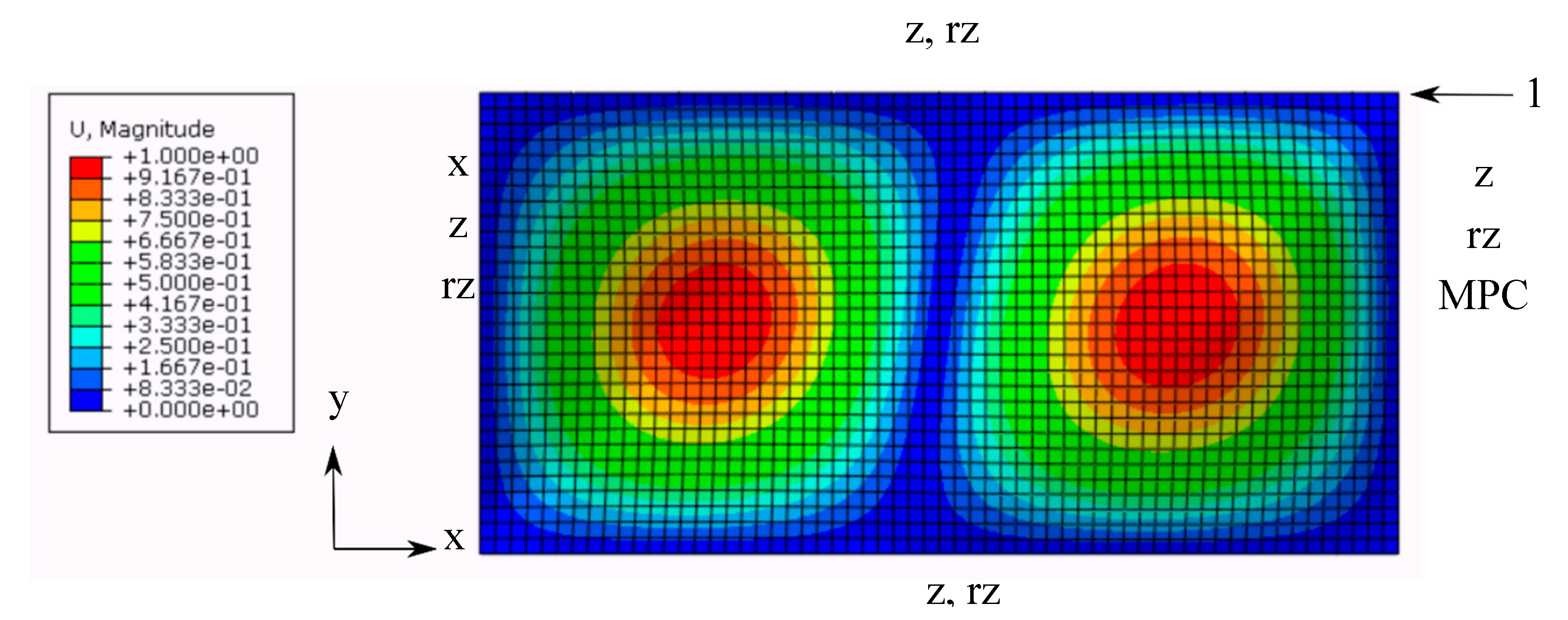

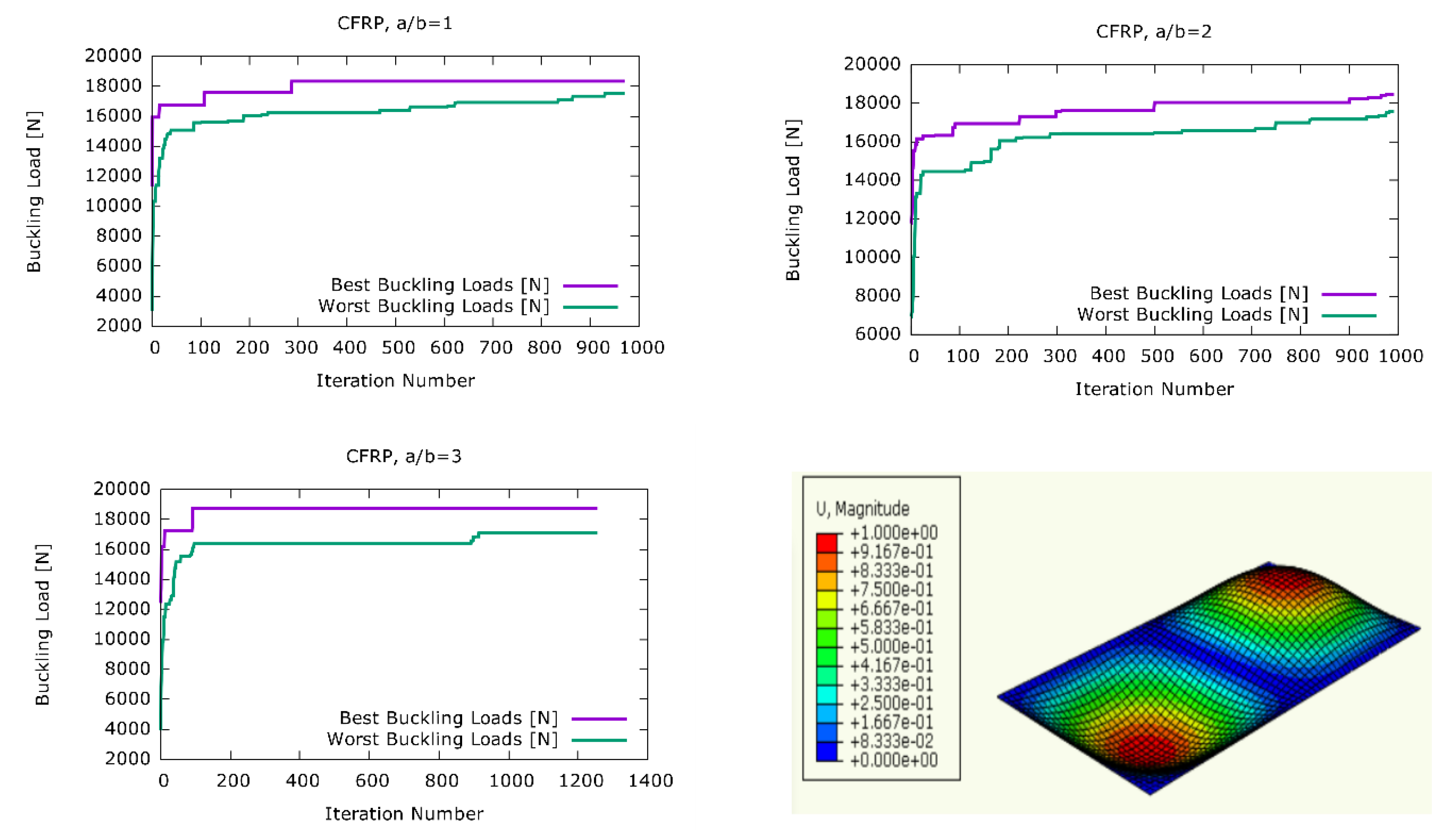
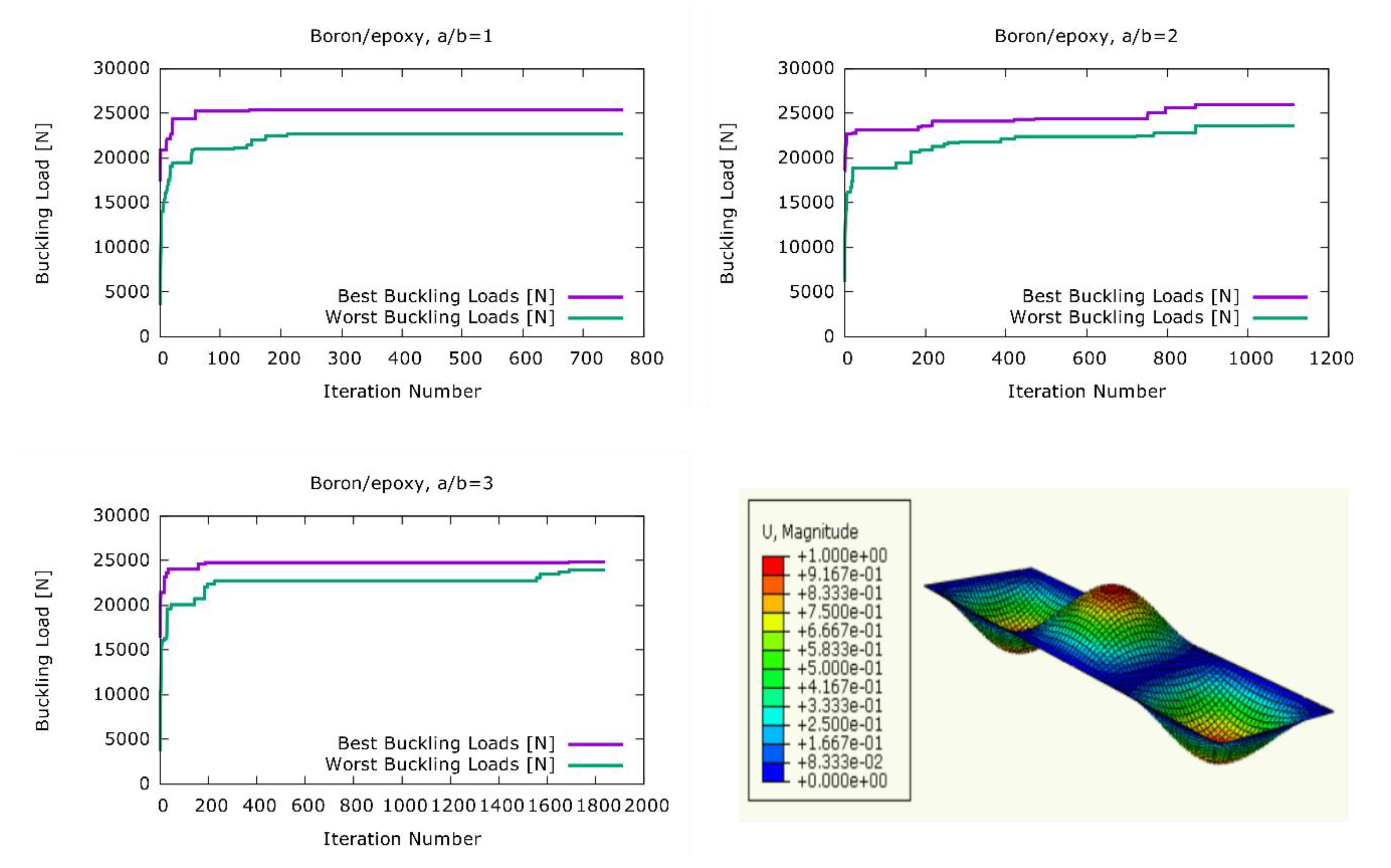
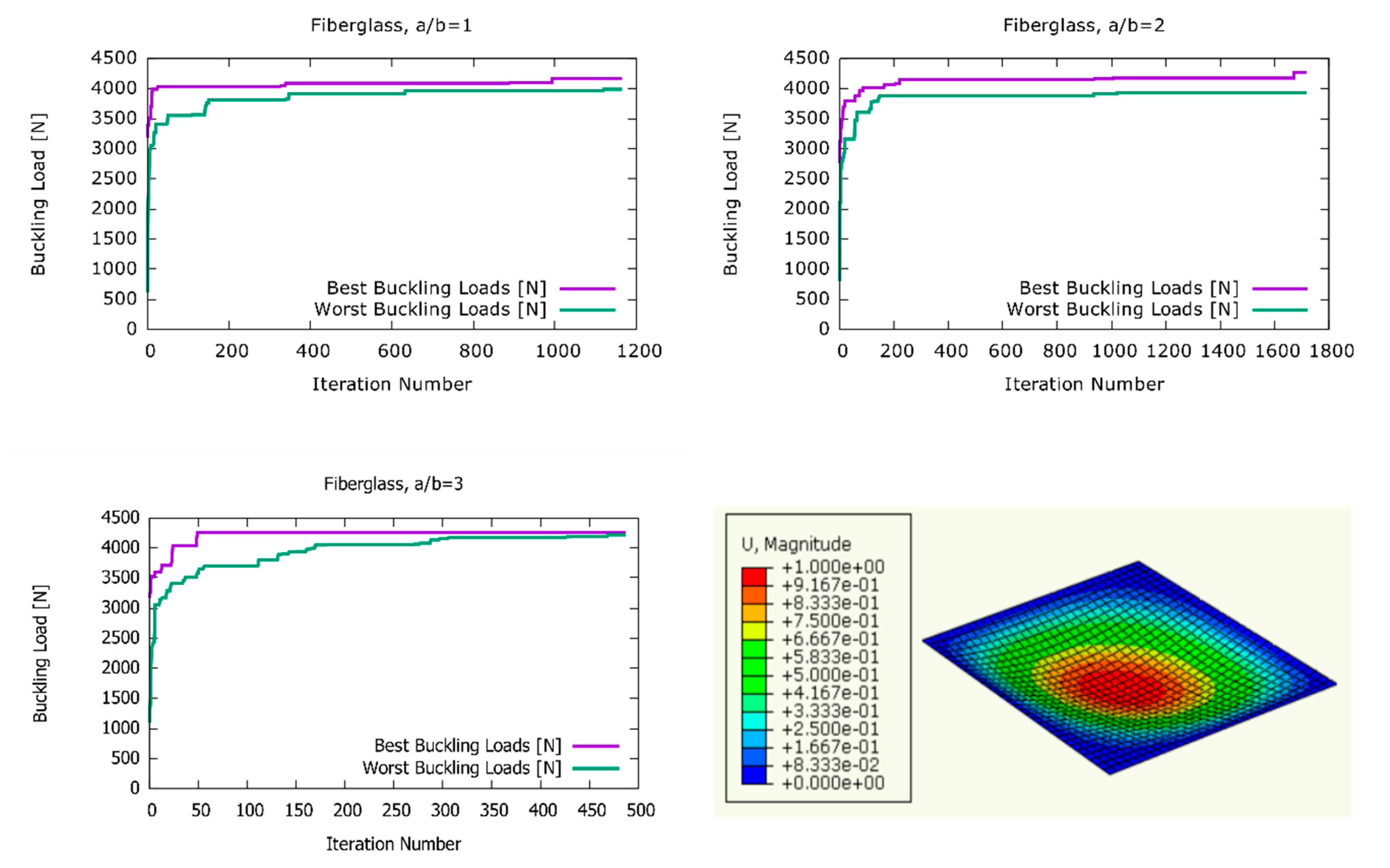
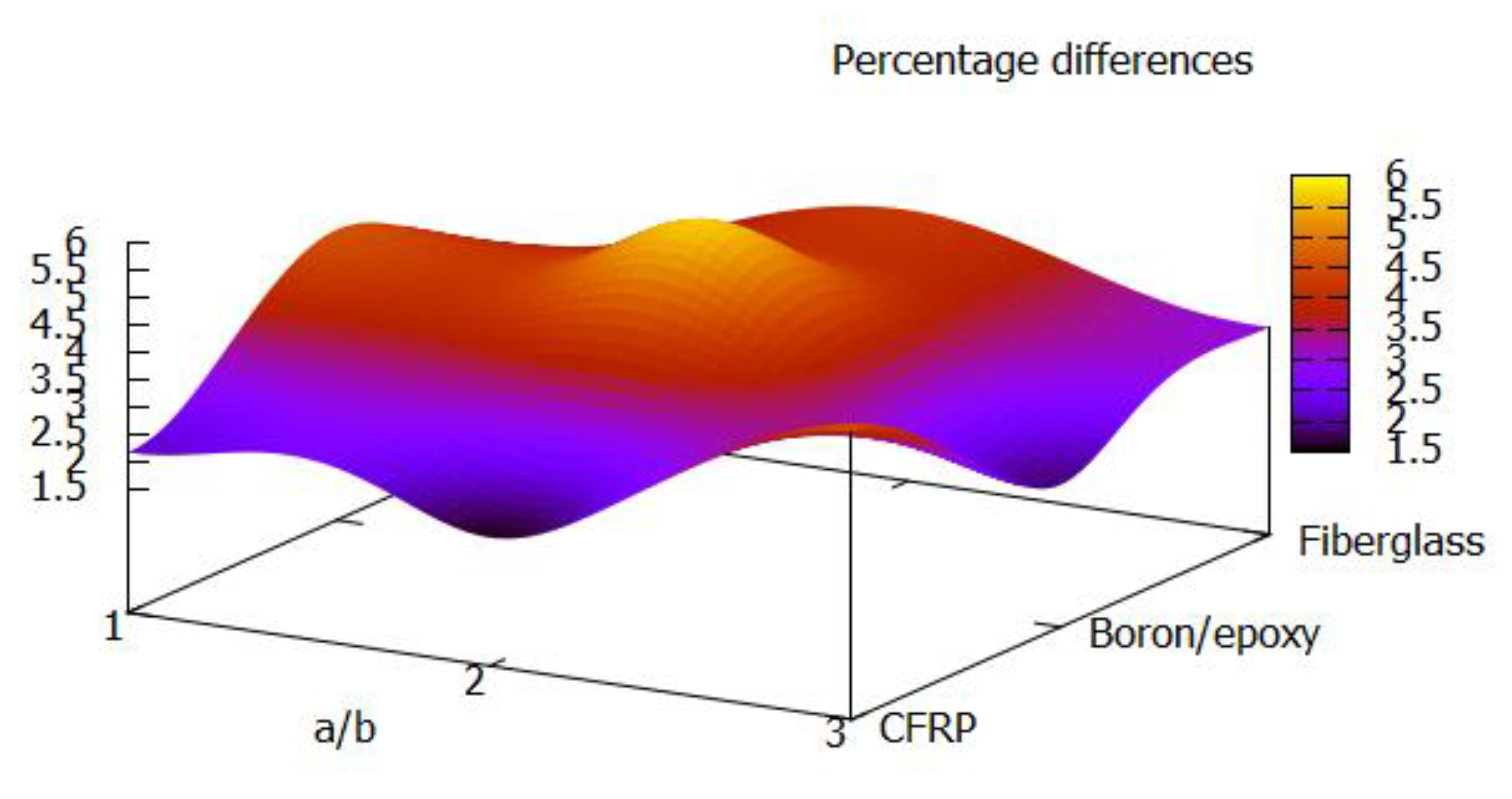
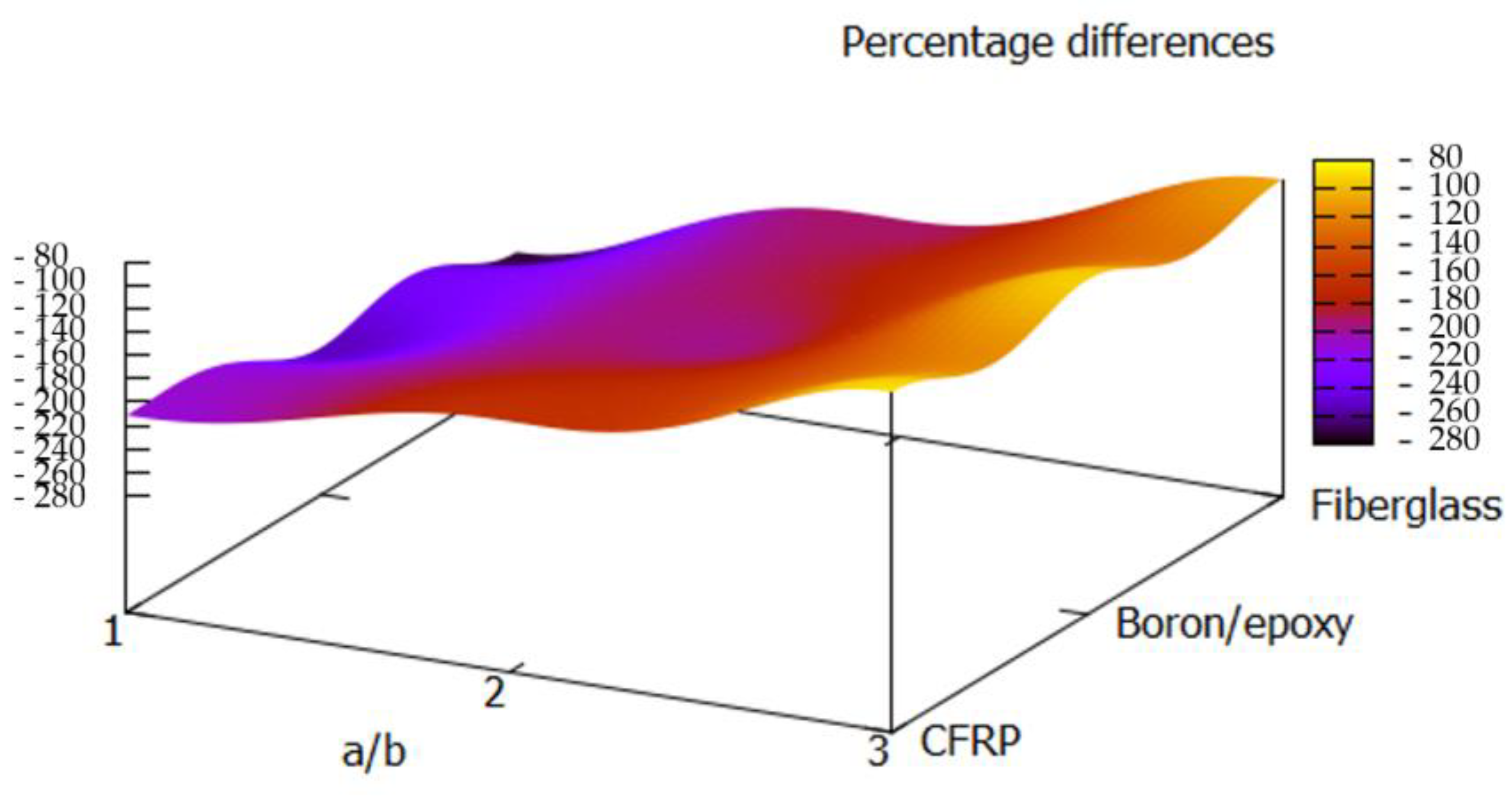
| Material Property | Carbon Fiber (CFRP) [28] |
|---|---|
| E1 [N/mm2] | 157,000 |
| E2 [N/mm2] | 8500 |
| G12 [N/mm2] | 4200 |
| 0.35 |
| Material Property | a/b = 1 | a/b = 2 | a/b = 3 |
|---|---|---|---|
| Total plate thickness (mm) | 2.25 | 2.247 | 2.248 |
| Max buck. load HS (N) | 18,337 | 18,446 | 18,722 |
| Max buck. load Führer [28] (N) | 17,947 | 18,157 | 17,916 |
| Best stacking sequence (degrees) | [−27/43/−64/62/31/−55/57/43/48] | [56/−48/58/60/31/66/40/51/−50] | [46/−40/55/29/80/3/73/46/−43] |
| Best ply thicknesses (mm) | [0.1/0.18/0.33/0.1/0.76/0.3/0.1/0.25/0.14] | [0.11/0.4/0.2/0.84/0.1/0.12/0.1/0.11/0.28] | [0.13/0.35/0.33/0.1/0.34/0.32/0.13/0.23/0.32] |
| Material Property | Carbon Fiber (CFRP) [28] |
|---|---|
| E1 (N/mm2) | 207,540 |
| E2 (N/mm2) | 19,790 |
| G12 (N/mm2) | 5520 |
| 0.225 |
| Material Property | a/b = 1 | a/b = 2 | a/b = 3 |
|---|---|---|---|
| Total plate thickness (mm) | 2.239 | 2.249 | 2.242 |
| Max buck. load HS (N) | 25,395 | 26,000 | 24,854 |
| Max buck. load Führer [28] (N) | 24,289 | 24,606 | 24,406 |
| Best stacking sequence (degrees) | [−47/51/−29/−38/61/55/86/42/−38] | [49/64/−32/−52/21/−82/−3/49/−47] | [64/39/3/49/−43/−47/−50/44/−43] |
| Best ply thicknesses (mm) | [0.12/0.43/0.16/0.46/0.21/0.1/0.14/0.37/0.26] | [0.22/0.1/0.1/0.28/0.11/0.12/0.32/0.66/0.34] | [0.1/0.1/0.11/0.1/0.22/0.1/1.03/0.29/0.2] |
| Material Property | Fiberglass [51] |
|---|---|
| E1 (N/mm2) | 33,000 |
| E2 (N/mm2) | 3100 |
| G12 (N/mm2) | 3000 |
| 0.26 |
| Title 1 | a/b = 1 | a/b = 2 | a/b = 3 |
|---|---|---|---|
| Total plate thickness (mm) | 2.244 | 2.246 | 2.248 |
| Max buck. load HS (N) | 4168 | 4270 | 4254 |
| Max buck. load Führer [28] (N) | 4069 | 4098 | 4129 |
| Best stacking sequence (degrees) | [−53/34/49/20/61/−76/−29/38/−45] | [41/50/−50/−16/−83/40/62/−51/−34] | [49/−47/68/45/−66/60/52/−36/−42] |
| Best ply thicknesses (mm) | [0.32/0.1/0.22/0.1/0.11/0.78/0.1/0.42/0.1] | [0.1/0.17/0.43/0.1/0.45/0.63/0.1/0.16/0.1] | [0.2/0.26/0.38/0.26/0.1/0.3/0.42/0.1/0.22] |
© 2020 by the authors. Licensee MDPI, Basel, Switzerland. This article is an open access article distributed under the terms and conditions of the Creative Commons Attribution (CC BY) license (http://creativecommons.org/licenses/by/4.0/).
Share and Cite
Cakiroglu, C.; Bekdaş, G.; Geem, Z.W. Harmony Search Optimisation of Dispersed Laminated Composite Plates. Materials 2020, 13, 2862. https://doi.org/10.3390/ma13122862
Cakiroglu C, Bekdaş G, Geem ZW. Harmony Search Optimisation of Dispersed Laminated Composite Plates. Materials. 2020; 13(12):2862. https://doi.org/10.3390/ma13122862
Chicago/Turabian StyleCakiroglu, Celal, Gebrail Bekdaş, and Zong Woo Geem. 2020. "Harmony Search Optimisation of Dispersed Laminated Composite Plates" Materials 13, no. 12: 2862. https://doi.org/10.3390/ma13122862
APA StyleCakiroglu, C., Bekdaş, G., & Geem, Z. W. (2020). Harmony Search Optimisation of Dispersed Laminated Composite Plates. Materials, 13(12), 2862. https://doi.org/10.3390/ma13122862







